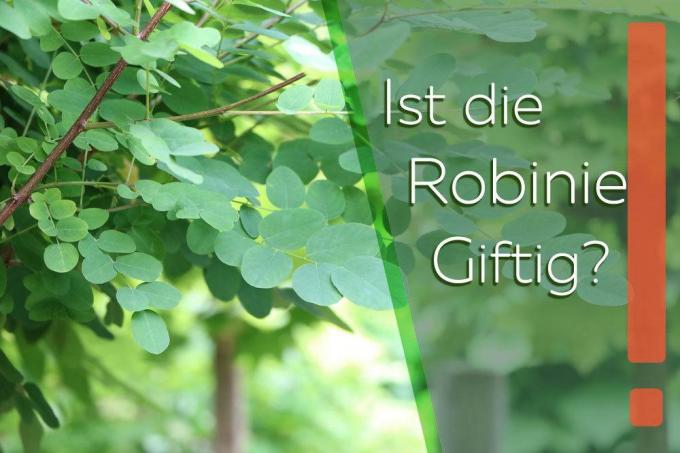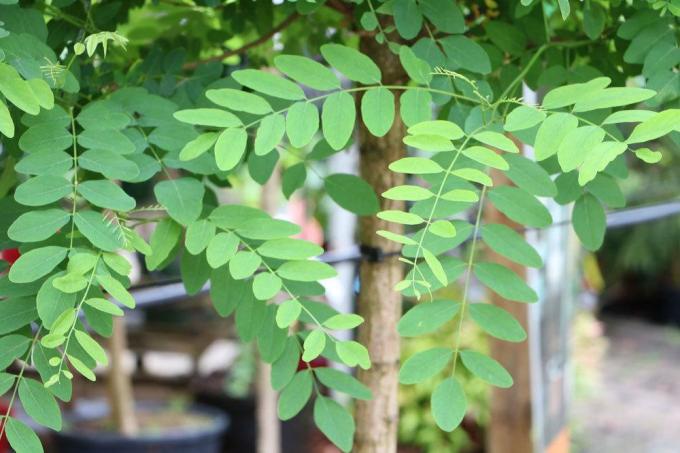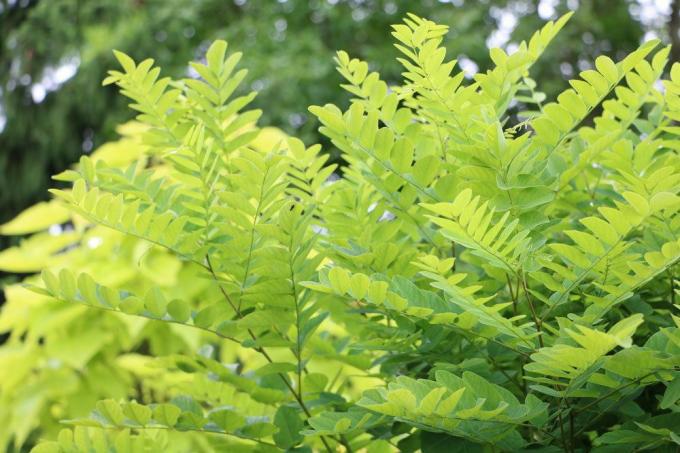
table of contents
- Is the black locust poisonous?
- Poisonous plant parts
- risk groups
- Symptoms
- First aid
It is not for nothing that the robinia, or pseudo-acacia, is nicknamed the silver rain. With its decorative, hanging flower umbels, it is the eye-catcher in numerous parks and private gardens. But be careful, because the black locust is generally classified as poisonous. In the following we explain how toxic it actually is for humans and animals.
Is the black locust poisonous?
The general term of toxicity is commonly used for many crops. A wide range of aspects can be concealed behind this term, from a pure intolerance for the human or animal digestive tract, for example can range from allergic reactions of particularly sensitive people to a real toxin content, which can sometimes have harmful or even fatal effects can.
For the Robinia, the term "poisonous“Draw. This is because it has been shown to contain considerable amounts of poisonous proteins, so-called toxalbumins, as well as lectins such as robin. From a biological point of view, they are real toxins, the consequences of which doctors will clearly classify as poisoning.
Poisonous plant parts
One often reads that all components of the pseudo acacia contain the toxalbumins. This is only partially true, because the conspicuous inflorescences in particular are non-toxic and can therefore be classified as uncritical in this matter. All other components, i.e. wood, bark, sap, leaves and seeds, contain more or less of these critical substances. They are particularly concentrated in the bark and seeds.
How does the poison get into the body?
The toxic substances of Robinia Pseudoacacia find access to the organism in a wide variety of ways in order to develop their harmful effects there:
- By swallowing or consumption
- Via mucous membranes in the mouth, nose and eyes
- Through intensive skin contact, especially through the smallest skin injuries
- BUT: poisoning through short-term skin contact or normally not possible after washing off sap from the skin

risk groups
The black locust can justifiably be called poisonous. Because their harmful effects affect both humans and animals.
people
In humans, as in most cases of adverse effects, the toxalbumins mainly affect children and the elderly. Because their organisms are weaker than those of adults and therefore suffer from the impairments to a particular degree.
Attention: When it comes to the subject of black locust poison, the focus is on children in particular. This is because they have a particular tendency to take small twigs, leaves or seeds in their mouths and thus actively supply themselves with the poison. This fact is particularly critical, as the flowers of the plant and, to a lesser extent, the wood give off a lovely, sweet smell!
animals
Rather unusual for plants classified as poisonous is the fact that the toxins of the black locust act on both birds and mammals and are therefore very universally effective. How strong the poison is can be seen in the fact that it is not only popular pets such as dogs and cats that suffer from it. Even large livestock, such as cattle or horses, can be significantly affected by the effects, in rare cases even to the point of death.
Symptoms
But now let's take a look at how the poisonous black locust affects the organisms of humans and animals. The appearances are always the same, regardless of whether they are children, adults, pets such as dogs or cats, or livestock:
Common effects:
- Increased salivation
- Urge to urinate
- Increased pulse
- nausea
- Dilated pupils
- Stomach cramps
- Vomit
- At first excitement, as the poisoning progresses indifference
In addition, if the dosage is high:
- Inflammation of the stomach and intestines
- Yellow discoloration of the mucous membranes
- Muscle spasms and convulsive twitching
- Disturbance of the sense of balance
- Damage to the liver and kidneys
- Going blind
- Death (in small animals such as dogs or cats, as well as small children)
The main difference between humans and animals lies in the amount of poison required before the symptoms of poisoning appear. The speed of symptom formation also depends on the amount of poison in relation to the poisoned organism.
First and foremost, the height and mass of the poisoned living being are decisive for the intensity and speed. An exact critical amount for life-threatening conditions has not been investigated in more detail and is therefore not clearly defined. However, the literature repeatedly gives an amount of around five seeds, or a comparable amount of wood, as the amount for causing the described symptoms of poisoning. Children and smaller pets, on the other hand, are likely to suffer from ingestion even with lower amounts.
First aid
As soon as the described signs of poisoning by the robinia are recognized, countermeasures should be initiated immediately. First aid looks like this:
- Drink plenty of fluids in order to transport poison out of the body through the increased fluid exchange.
- Induce vomiting after known consumption of wood, seeds or leaves
- Go to Art, alert the emergency doctor in the event of intense symptoms
If a doctor removes the toxin after taking immediate measures, this is usually done by giving activated charcoal and a Monitoring of the body functions in order to recognize any increasing effects at an early stage and the body functions to ensure.
Attention: Since the first signs of poisoning are rather unspecific and cannot be precisely assigned, should also the described first aid was already taken if there was a suspicion of poisoning by the silver rain will. Since the measures do not pose any dangers, early action counts far more than a possibly premature or unnecessary reaction.
Note: Please note that this article does not in any way replace a visit to the doctor. There is no guarantee that medical statements are correct.
You will find detailed information on first aid in the event of poisoning and important information on poison control centers here.

